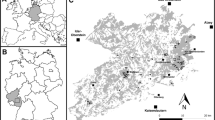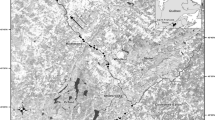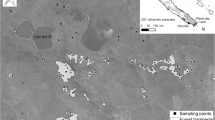Abstract
In North-western Germany woodland fragmentation has caused a decline in many forest plant species. Hedgerows partly offer a similar environment as forests and have been identified as potential habitats for forest plants in various studies from North America and Western Europe. The objective of this study was to examine whether this applies also to Central Europe and which variables affect the spatial distribution and abundance of forest plant species in hedgerows on a local scale. Three hedgerow networks north of the city of Bremen, Germany, were selected as study areas and divided into totally 515 hedgerow segments. In each segment we recorded all vascular plants and a large number of explanatory variables relating to structure, spatial configuration, environment and management. Averaged across species there was a predominant effect of environmental factors on the occurrence of forest species in the hedgerows, followed by spatial configuration and management. Hedgerow structure was found to be less important. In general, forest species were favored by low nutrient and light availability as well as high connectivity with other hedgerows or forest; they avoided hedgerows with a west-easterly orientation and an adjacent land use in the form of fields or grasslands. Forest species found and not found in hedgerows did not differ in their environmental preferences or life history traits. The number of threatened forest species in the hedgerows, however, was lower than expected with respect to their overall proportion to the total number of forest species in the region.


Similar content being viewed by others
Abbreviations
- hFint :
-
Herbaceous species preferring the forest interior
- hFedge :
-
Herbaceous species preferring forest edges and gaps
- ENV:
-
Variable group environment
- MAN:
-
Variable group management
- SPA:
-
Variable group spatial configuration
- STR:
-
Variable group structure
References
Andrews M, Mercer C, Griffin P, Andrews ME, Cherrill A (1999) Autecology of common herbaceous hedgerow species in Britain. Aspect Appl Biol 54:353–360
Baudry J, Bunce RGH, Burel F (2000) Hedgerows: an international perspective on their origin, function and management. J Environ Manage 60:7–22
Boatman N, Blake KA, Aebischer NJ, Sotherton NW (1994) Factors affecting the herbaceous flora of hedgerows on arable farms and its value as wildlife habitat. In: Watt TA, Buckley P (eds) Hedgerow management and nature conservation. Wye College Press, Ashford, pp 33–46
Boutin C, Jobin B, Bélanger L, Baril A, Freemark KE (2001) Hedgerows in the farming landscapes of Canada. In: Barr CJ, Petit S (eds) Hedgerows of the world: their ecological functions in different landscapes. IALE, Birmingham, pp 33–42
Burel F (1996) Hedgerows and their role in agricultural landscapes. Crit Rev Plant Sci 15:169–190
Burel F, Baudry J (1990a) Hedgerow networks as habitats for forest species: implications for colonising abandoned agricultural land. In: Bunce RGH, Howard DC (eds) Species dispersal in agricultural habitats. Belhaven Press, London, pp 238–255
Burel F, Baudry J (1990b) Structural dynamic of a hedgerow network landscape in Brittany France. Landsc Ecol 4:197–210
Burel F, Baudry J (1994) Control of biodiversity in hedgerow network landscapes in Western France. In: Watt TA, Buckley P (eds) Hedgerow management and nature conservation, Wye College Press, Ashford, pp 47–57
Burel F, Baudry J, Butet A, Clergeau P, Delettre Y, Le Coeur D, Dubs F, Morvan N, Paillat G, Petit S, Thenail C, Brunel E, Lefeuvre JC (1998) Comparative biodiversity along a gradient of agricultural landscapes. Acta Oecol 19:47–60
Cherrill A, Mercer C, McClean C, Tudor G (2001) Assessing the floristic diversity of hedge networks: a landscape perspective. Landsc Res 26:55–64
Corbit M, Marks PL, Gardescu S (1999) Hedgerows as habitat corridors for forest herbs in central New York, USA. J Ecol 87:220–232
Cordes H, Feder J, Hellberg F, Metzing D, Wittig B (eds) (2006) Atlas der Farn- und Blütenpflanzen des Weser-Elbe-Gebietes. H.M. Hausschild, Bremen
Cummins RP, French DD (1994) Floristic diversity, management and associated land use in British hedgerows. In: Watt TA, Buckley P (eds) Hedgerow management and nature conservation, Wye College Press, Ashford, pp 95–106
de Blois S, Domon G, Bouchard A (2002) Factors affecting plant distribution in hedgerows of southern Quebec. Biol Conserv 105:355–367
Deckers B, Hermy M, Muys B (2004) Factors affecting plant species composition of hedgerows: relative importance and hierarchy. Acta Oecol 26:23–37
Deckers B, De Becker P, Honnay O, Hermy M, Muys B (2005) Sunken roads as habitats for forest plant species in a dynamic agricultural landscape: effects of age and isolation. J Biogeogr 32:99–109
Dover JW, Sparks TH (2001) Green lanes: biodiversity reservoirs in farmland? In: Barr CJ, Petit S (eds) Hedgerows of the world: their ecological functions in different landscapes. IALE, Birmingham, pp 241–250
Dupré C, Ehrlén J (2002) Habitat configuration, species traits and plant distributions. J Ecol 90:796–805
Ellenberg H, Weber HE, Düll R, Wirth V, Werner W, Paulißen D (1992) Zeigerwerte von Pflanzen in Mitteleuropa. Scripta Geobotanica 18:1–258
Forman RTT, Baudry J (1984) Hedgerows and hedgerow networks in landscape ecology. Environ Manage 8:495–510
French DD, Cummins RP (2001) Classification, composition, richness and diversity of British hedgerows. Appl Veg Sci 4:213–228
Fritz R, Merriam G (1993) Fencerow habitats for plants moving between farmland forests. Biol Conserv 64:141–148
Garve E (2004) Rote Liste und Florenliste der Farn- und Blütenpflanzen in Niedersachsen und Bremen. Informationsdienst Naturschutz Niedersachsen 24:1–76
Grashof-Bokdam C (1997) Forest species in an agricultural landscape in the Netherlands: Effects of habitat fragmentation. J Veg Sci 8:21–28
Hegarty CA, McAdam JH, Cooper A (1994) Factors influencing the plant species composition of hedges—implications for management in environmentally sensitive areas. Br Crop Prot Counc Monogr 58:227–234
Helliwell DR (1975) The distribution of woodland plant species in some shropshire hedgerows. Biol Conserv 7:61–72
Jobin B, Boutin C, Bélanger L (2001) Hedgerows as refuges for pest birds and plants: could Québec’s farmers be wrong? In: Barr CJ, Petit S (eds) Hedgerows of the world: their ecological functions in different landscapes. IALE, Birmingham, pp 207–212
Jobin B, Boutin C, DesGranges JL (1997) Effects of agricultural practices on the flora of hedgerows and woodland edges in southern Quebec. Can J Plant Sci 77:293–299
Kleijn D, Verbeek M (2000) Factors affecting the species composition of arable field boundary vegetation. J Appl Ecol 37:256–266
Klotz S, Kühn I, Durka W (2002) Eine Datenbank mit biologisch-ökologischen Merkmalen zur Flora von Deutschland. Schriftenreihe für Vegetationskunde 38:1–334
Kolb A (2005) The distribution of forest plant species in a fragmented landscape: patterns and processes. Dissertation, University of Bremen
Le Coeur D, Baudry J, Burel F (1997) Field margins plant assemblages: variation partitioning between local and landscape factors. Landsc Urban Plan 37:57–71
Legendre P, Legendre L (1998) Numerical ecology. Elsevier Science, Amsterdam
Martin B, Vanpeene-Bruhier S, Brun JJ (2001) Spatial and ecological knowledge of the mountain bocage of Champsaur (French Alps). In: Barr CJ, Petit S (eds) Hedgerows of the world: their ecological functions in different landscapes. IALE, Birmingham, pp 273–278
McCollin D, Jackson JI, Bunce RGH, Barr CJ, Stuart R (2000) Hedgerows as habitat for woodland plants. J Environ Manage 60:77–90
Mercer C, Cherrill A, Tudor G, Andrews M (1999) Hedgerow plant communities: relationship with adjacent land use and aspect. Aspect Appl Biol 54:345–352
Petit S, Griffiths L, Smart SS, Smith GM, Stuart RC, Wright SW (2004) Effects of area and isolation of woodland patches on herbaceous plant species richness across Great Britain. Landsc Ecol 19:463–471
Pollard E (1973) Hedges: VII. Woodland relic hedges in Huntington and Peterborough. J Ecol 61:343–352
Roy V, de Blois S (2006) Using functional traits to assess the role of hedgerow corridors as environmental filters for forest herbs. Biol Conserv 130:592–603
Schmidt M, von Oheimb G, Kriebitzsch WU, Ellenberg H (2002) Liste der im norddeutschen Tiefland typischen Waldgefäßpflanzen. Mitt Bundesforsch 206:1–37
Smart SM, Bunce RGH, Stuart RC (2001) An assessment of the potential of British hedges to act as corridors and refuges for ancient woodland indicator plants. In: Barr CJ, Petit S (eds) Hedgerows of the world: their ecological functions in different landscapes. IALE, Birmingham, pp 137–146
Tsiouris S, Marshall EJP (1998) Observations on patterns of granular fertiliser deposition beside hedges and its likely effects on the botanical composition of field margins. Ann Appl Biol 132:115–127
Wisskirchen R, Haeupler H (1998) Standardliste der Farn- und Blütenpflanzen Deutschlands. Ulmer, Stuttgart
Acknowledgments
We are grateful for the grant to S.W. from the German Federal Environmental Foundation (Deutsche Bundesstiftung Umwelt, DBU). Detlev Metzing provided the floristic mapping data for the study region. We also thank our colleagues at the University of Bremen for advice and assistance.
Author information
Authors and Affiliations
Corresponding author
Rights and permissions
About this article
Cite this article
Wehling, S., Diekmann, M. Factors influencing the spatial distribution of forest plant species in hedgerows of North-western Germany. Biodivers Conserv 17, 2799–2813 (2008). https://doi.org/10.1007/s10531-007-9294-z
Received:
Accepted:
Published:
Issue Date:
DOI: https://doi.org/10.1007/s10531-007-9294-z




